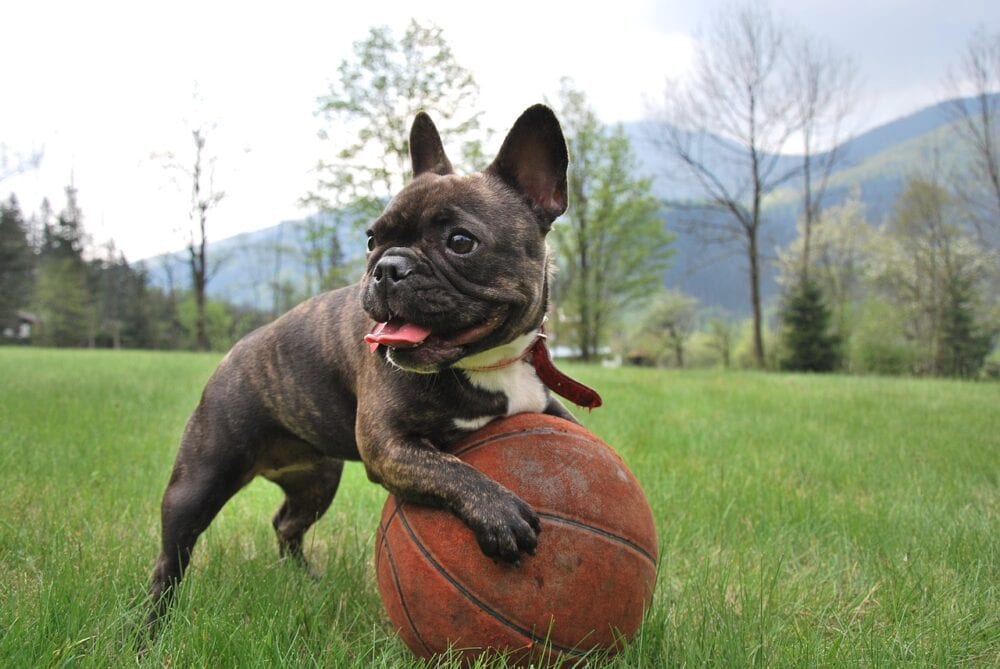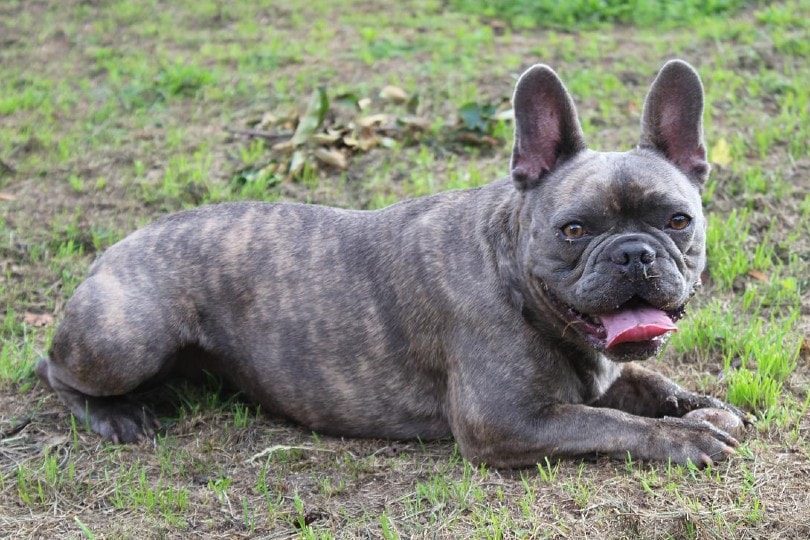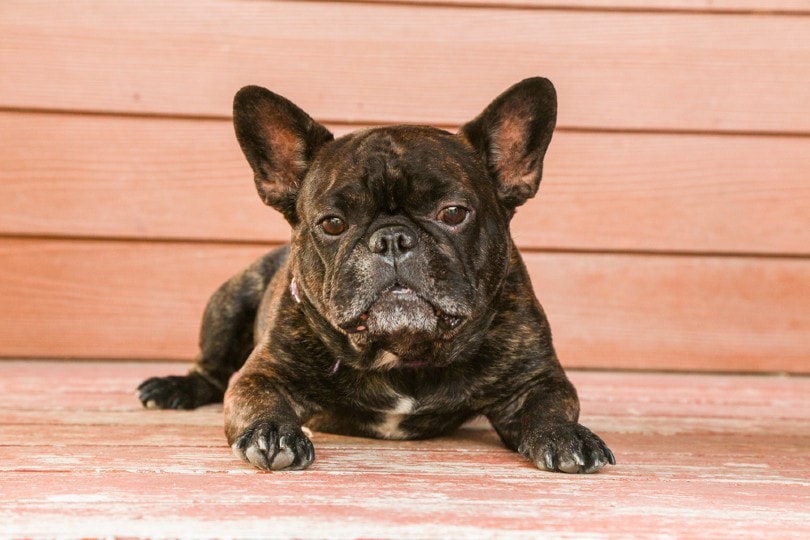Click to Skip Ahead
In 2022, the French Bulldog, affectionately known as the “Frenchie,” became number 1 on the American Kennel Club’s list of most popular dog breeds, and we’re not surprised! French Bulldogs are wildly popular today because they’re quirky, cute, funny, and loving.
Breed Overview
Height:
Small to medium (11–12 inches)
Weight:
20–28 pounds for males, 16-24 pounds for females
Lifespan:
10–12 years
Colors:
Fawn, fawn and white, fawn brindle, brindle, brindle and white, cream, white and brindle, white and fawn
Suitable for:
Families looking for playful, easy-to-groom lapdogs
Temperament:
Easygoing, sociable, gentle, friendly, playful, affectionate
French Bulldogs come in a variety of coat colors and patterns, including brindle. Dogs with a brindle coat color pattern have a reddish or brown base color covered with darker stripes. It’s a common coloring pattern in French Bulldogs but certainly one of the most striking. Color aside, all Frenchies have a history as quirky and colorful as they are, so let’s explore further!
French Bulldog Characteristics

The Earliest Records of Brindle French Bulldogs in History
When blood sports were banned in Britain in 1835, Bulldog breeders found a new way to make money: breeding dogs for show. Small Bulldogs came to be distinguished at these shows as “Toy Bulldogs.”
The smaller dogs headed to France during the Industrial Revolution, where their popularity grew. The earliest photo of a brindle Frenchie dates back to 1901, but they were certainly around long before that.

How Brindle French Bulldogs Gained Popularity
When the Industrial Revolution started to replace human workers with machines and put skilled artisans out of work, these workers left Britain for northern France, where there was still a demand for skilled lace workers. Their canine companions, little toy Bulldogs, were by their sides on the journey.
It was in France that Toy Bulldogs’ popularity exploded, and breeders started to send them over from Britain to fulfill the demand. The dogs they sent didn’t fit the Bulldog breed standard—dogs with sticky-uppy ears and very small stature—and were renamed “Bouledogue Français,” which translates to “French Bulldog.”
These dogs soon became companions to people from all walks of life, including rich socialites and those on the margins of society. In Paris, it wasn’t uncommon to see a Frenchie scurrying along at the heels of ladies of the night in Montmartre, which was home to quite a few brothels at the time.
It is unknown which French Bulldog coat color was most popular at the time, but because brindle is a common coat color pattern, it seems likely that it was one of them!
Formal Recognition of Brindle French Bulldogs
French Bulldogs were recognized by the American Kennel Club in 1898. In Britain, it wasn’t until 1905 that French Bulldogs were recognized as a separate breed from English Bulldogs.
Brindle is one of the coat coloring patterns accepted by the American Kennel Club, along with fawn and pied.
Top 3 Unique Facts About Brindle French Bulldogs
1. French Bulldogs Can’t Swim
For Frenchies, due to their flat noses, stocky bodies, and the need to hold their heads high up out of the water, swimming is not their forte. If you plan on cracking out the old paddling pool this summer, be sure to supervise your Frenchie around the water or keep it shallow enough so they can enjoy paddling without actually swimming.
2. The Romanov Family Owned a Brindle Frenchie
As Frenchies became increasingly popular, both within Europe and outside of it, they caught the attention of the Russian Imperial Family, who went on to keep them as pets. There is a photo of Grand Duchess Tatiana with her brindle French Bulldog Ortipo, who was her loyal companion until the final moments of her life. It is said that Ortipo even tried to protect the Romanov family’s bodies from their killers.

3. French Bulldogs Often Need Help to Reproduce
In many cases, French Bulldogs are artificially inseminated to help them reproduce. Their body types make it difficult to reproduce naturally.

Does a Brindle French Bulldog Make a Good Pet?
French Bulldogs of any coloring pattern make great companions thanks to their fun-loving, affectionate nature. They love spending time with their families, and many are friendly with strangers, too. However, due to their flat faces and short noses, they are prone to health conditions like brachycephalic airway syndrome, which results in loud breathing, snoring, and snorting in mild cases.
In severe cases, they may breathe even more loudly than usual and suffer from exhaustion when it’s hot or when they exercise. Some dogs collapse from the effort involved in exercising and may cough, gag, or vomit. French Bulldogs also become very attached to their families and are prone to separation anxiety.
Conclusion
The French Bulldog has one of the most intriguing histories of any breed. They were bred purely as companion dogs and have not disappointed, remaining faithful friends to many dog parents across continents for centuries.
If you’re considering getting a French Bulldog, we urge you to consider adoption. Though French Bulldogs are not the breed most commonly found in shelters, many agencies and rehoming centers are still seeking out loving homes for adorable Frenchies.
See Also:
- Are French Bulldogs Smart? Breed Intelligence Facts & Care Tips
- How to Potty Train a French Bulldog: 8 Vet Approved Tips & Tricks
Featured Image Credit: Irit, Shutterstock











